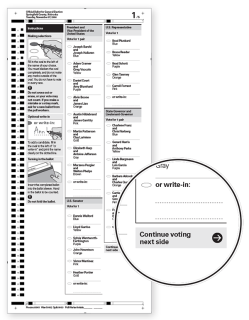Vol. 2 Writing instructions voters understand
It’s amazing the difference simple language can make for voters. In research conducted for the U.S. National Institute of Standards and Technology (NIST), Ginny Redish and Dana Chisnell found that when instructions on ballots were in plain language, voters made fewer mistakes and were more likely to vote the way they intended.
What is plain language?
According to the Center for Plain Language, something is in plain language if it considers who will use it, why they will use it, and what they will do with it. The language used minimizes jargon and uses sentence structure, strong verbs, word choice, and other similar techniques to make sure that the audience can read, understand, and use the information.
No. 01
At the beginning of the ballot, explain how to change a vote, and that voters may write in a candidate.

On optical scan ballots, instructions like these are most effective when placed just before the first contests.
No. 02
Put instructions where voters need them.
Break instructions into groups.
On paper ballots, place instructions to turn the ballot over at the bottom right hand corner.
On electronic ballots, put instructions for writing in candidates on the write-in screen.

Continue voting next side instruction is placed at the end of the last column on the page.
No. 03
Include information that will prevent voters from making errors.
Show and tell voters how to mark the ballot.
Tell voters not to write in candidates whose names already appear on the ballot.
Simple illustrations, along with clear instructions, help voters know what to do.
No. 04
Write short sentences.
Use simple words.
Remove unnecessary words.
Separate instructions from results.
Before
If you tear, or deface, or wrongly mark this ballot, return it and obtain another. Do not attempt to correct mistakes on the ballot by making erasures or cross outs. Erasures or cross outs may invalidate all or part of your ballot. Prior to submitting your ballot, if you make a mistake in completing the ballot or wish to change your ballot choices, you may obtain and complete a new ballot. You have a right to a replacement ballot upon return of the original ballot.
After
If you make a mistake, ask a poll worker for another ballot.
No. 05
Use short, simple everyday words.
Select the plain rather than the formal word.
Avoid jargon, such as “over vote,” “under vote,” and “partisan.”
Use
find
help
make sure
message
put
turn on
use
Avoid
locate, identify
assist
verify, validate, prompt
prompt
incorporate
power on
utilize
No. 06
Write in the active voice, where the person doing the action comes before the verb.
Think of the voter as “you.”
Write instructions where the subject is “you,” implied or understood.
You don’t have to state “you” directly.
Before
Moving ahead is accomplished by touching the word Next; moving back by pressing Back.
After
To go forward in the ballot, touch Next.
To go back to previous pages in the ballot, touch Back.
No. 07
Write in the positive.
Tell voters what to do rather than what not to do.
Before
If that oval is not marked, your vote cannot be counted for the candidate.
After
You must fill in the oval for your vote to count.
No. 08
When giving instructions that are more than one step, make each step an item in a numbered list.
Do not number other instructions. When the instructions are not sequential steps, use separate paragraphs or simple bullets with bold beginnings rather than numbering.
Non-sequential steps
Vote!
- Mark your votes in private.
- Follow the instructions on the ballot.
- Do not write your name or an ID number anywhere on the ballot.
Sequential steps
To make changes:
- Touch the race you want to change.
- At that race, if you have selected something before, touch the choice you do not want.
- Then touch choice you want.
- To return to this screen, touch Return to Review.
No. 09
Keep paragraphs short.
A one-sentence paragraph is fine.
Good
If you need any help while voting, please contact your county elections office.
Seal the envelope to keep your votes private.
Do not write on this envelope.
No. 10
Separate paragraphs by a space so each paragraph stands out on the page or screen.
Before
Press the box of the candidate for whom you desire to vote; yellow will appear in the box. The voter must retouch the selected item to deselect it first in order to change a vote.
After
To vote for a candidate of your choice, touch that person’s name.
If you make a mistake or want to change a vote, first touch the name you no longer want.


